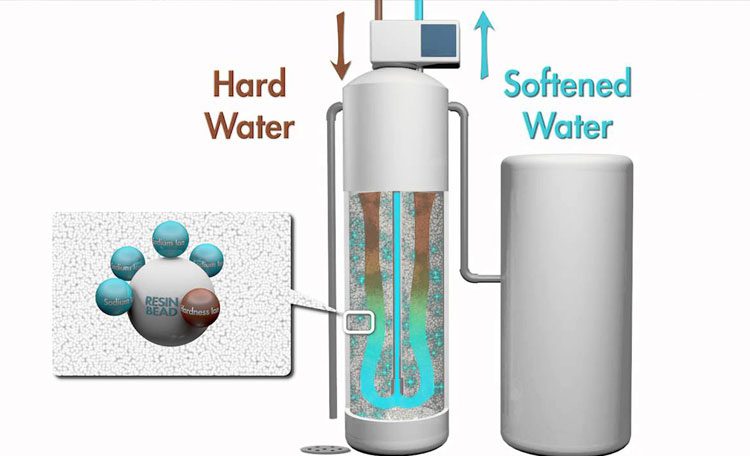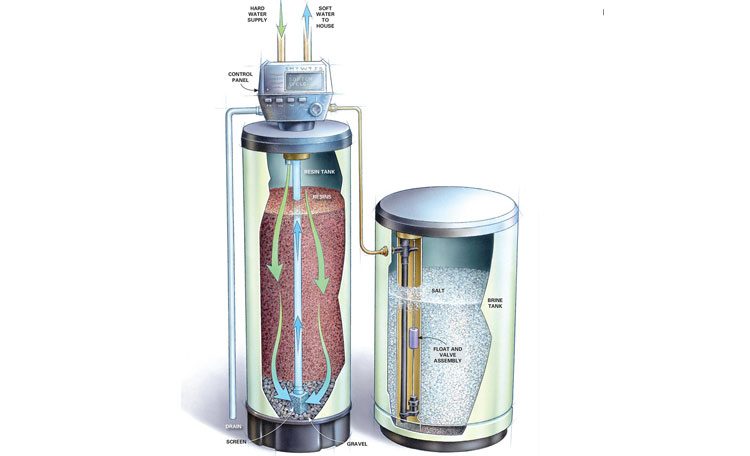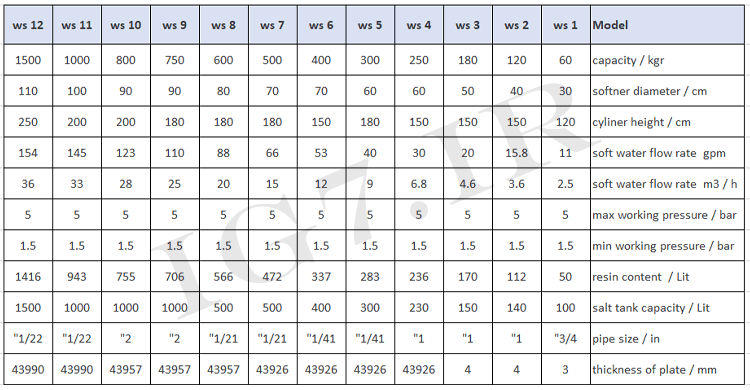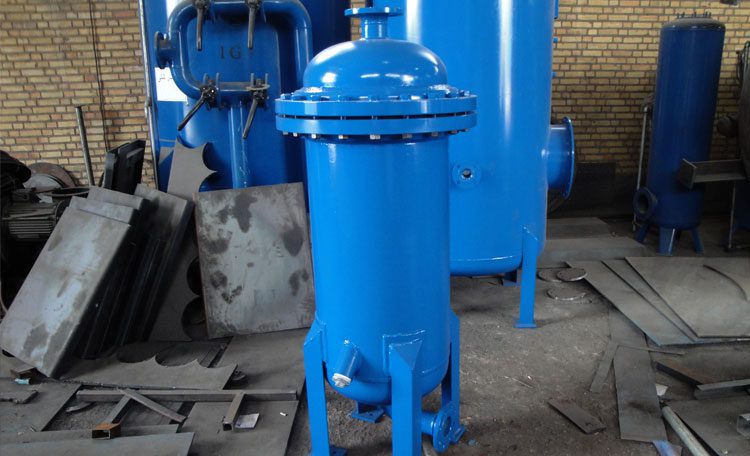Water Softener is one of the most important water purifiers in which the main purpose is to remove ions such as calcium and magnesium from water. This method of water purification is widely used due to the negative effect of high consumption of calcium and magnesium in water on the health of the body and kidneys, as well as the formation of sediment in boilers and other industrial tanks. So that the types of devices used in water hardening such as resin hardener, magnetic hardener and electronic hardener are designed and produced. Haft Industrial Group, as one of the most reputable design and production teams for resin hardeners and other types of water hardeners, will introduce the types of water hardeners, advantages, applications and important points in using this device.
What is a water softener?
Hard water is water that has a high volume of ions such as calcium and magnesium for various reasons, such as passing through different layers of soil. These salts and ions gradually deposit in the walls of containers, pipes and walls due to rising water temperatures. In addition, consuming water with a hardness above 500 ppm can lead to kidney stones and can cause many problems.
Removal of water hardness, which is known as water softener, is done by various methods, which in a general category can be divided into temporary softener and permanent softener. In many cases, a large volume of salts, calcium and magnesium in the water settles and precipitates due to heating and boiling water in the walls and bottom of the container. This type of hardness is temporary or carbonate hardness and can be easily removed. In another type of water hardness, which is known as permanent hardness and the salts in water are non-carbonated, they can be removed only by industrial methods and with different chemicals and processes.
Reasons why it is important to remove water hardness
As mentioned, water hardness removers are widely used in domestic and industrial applications due to the harmful effects of salts in water on various environments. The main reasons for the importance of removing water hardness are:
· Calcium and magnesium chlorides in water severely corrode boiler walls, water pipes, and other metals.
· Calcium and magnesium sulfates eventually build up on walls and waterways in power plants, home water pipes, and water heaters.
· The presence of more than 3000 mg of sodium chloride in water causes salinity, bad taste and non-drinkability.
· The CO2 released from the potassium and sodium carbonate and bicarbonate will react with the water to produce carbonic acid. Carbonic acid has a strong negative effect on the pipes and walls of industrial boilers.
· Excessive hardness in water is harmful to human health and includes the formation of kidney, bladder and indigestion stones.
· Sedimentation in high pressure boilers, which reduces the efficiency due to low heat transfer and thus increases the operating temperature of the boiler by the user to compensate for the heat transfer deficit and consequently increase fuel consumption.
· Sedimentation in cooling towers, chillers and other heating and refrigeration systems and reducing their efficiency or failure of the entire system
· Due to the hardness of the water, the washing power of all soaps is reduced so that the efficiency of detergents in hard water is half that of soft water.
· In the textile and dyeing industries, it causes a decrease in dye quality.
Application of water softener
As mentioned, the hardness of water will have a negative effect not only on people’s health but also on the quality of products produced in the industry. As a result, it can be used in various fields, the most important of which are the following:
· Prevent sedimentation in expensive devices
· Reduce hardness and purify drinking water
· Prevention of clogged pipes
Important steps in getting water hardness
At present, water softener is produced in different factories, each of which has special features and capabilities. But before starting the process of removing water hardness, it is necessary to answer some important questions, which are:
· What are the types of substances and ions in water? What is the value of each? Is the water analysis completely done?
· Is water hardness temporary or permanent? Is it carbonate or bicarbonate?
· According to the data obtained from water analysis, how many chemicals are needed and what kind of them are needed?
· Possibility of mixing water with chemicals
· Calculate the water hardening time
· Separation of sediment and extraction of soft water
Types of methods for removing hardness from water
The methods of obtaining soft water and removing the salts in the water vary according to the amount of salts, their type, as well as the industry that uses soft water. In general, there are several common methods for water softener, the most important of which are the following:
· Resin Softener
· Magnetic Softener
· Reverse osmosis
· Electronic Softener
· Use a carbon filter
In designing and manufacturing water softener, the type of device is determined according to the process and method used to separate salts and ions. Each of these devices uses different methods to remove water hardness. For example, some people use chemicals to remove calcium and sodium and convert them to sodium salts. In some devices, magnetic methods are used and can be very effective in capturing the hardness of water, and in some, combined methods are used.
Resin Softener
One of the common methods of de-hardening is the use of resin softeners. The device consists of a metal cylinder inside which the descaling agent (ion exchange resin) is placed. These resins can exchange sodium ions with calcium and magnesium ions in water and replace them. Commissioning, operation and reloading of the device can be done manually and semi-automatically or fully automatically. Resin softeners used in water treatment are mostly in the form of metal cylinders, in which resin particles are placed.
The use of resin in water purification and its hardness removal is in two types of automatic and semi-automatic, each of which has special characteristics. One of the differences is the way the Softener is regenerated and cleaned. In the fully automatic Softener, the washing process, which is often backwashing, is performed automatically without the need for operator or human intervention, and the resins are regenerated. In contrast, for cleaning resins in the semi-automatic Softener type, the operator performs this process.
One of the most important applications of resin softener is resin softening in leather, textile, carpet washing, dairy and food industries, oil and petrochemical industries, concreting and construction.
Components of resin softener tanks
Reservoir
The resins are placed inside these tanks. In fact, the purification process takes place in this part. In the design and production of the resin softener, great importance is given to the shape and general structure of the tank. The location of inlet and outlet valves and multiple valves in it is determined with high sensitivity. In addition, the material used for the tank is very important and often stainless steel (SS) carbon sheet is used for this purpose.
Resin
Resins are materials obtained by polymerization of organic compounds. Different number of resins are used inside the softener tank depending on the type of solutes and ions as well as their amount. In order to prevent the resins from escaping from the ion nozzle and also to remove larger suspended particles in the water, the resins are placed on a bed of silica. Waters that contain iron, manganese, copper, and other heavy metals will erode the resins and reduce the yield of the softener.
Nozzles
Nozzles are used to collect purified water. The material used in the production of resin softener for nozzles is often brass, plastic and PVC.
Water and salt solution tank
The contents of these tanks are used to regenerate the resin. Resins lose their effectiveness over time due to the presence of iron, manganese and other metals, and eventually the performance of the device will be disrupted. For this purpose, in the production of water softener, a type of PVC tank that is connected to the main tank is considered. In this tank, salt and water are placed, which is very effective in washing and regenerating the nozzles.
· Resin hardness manometer
Used to control the inlet pressure.
· Solid valve
Used to adjust the tank inlet.
How the resin softener works
- The way it works is that when water enters from the upper part of the water tank, it comes in contact with the resins, and in this case, the ion exchange process takes place.During the ion exchange process, the resins remove hard ions (magnesium and calcium) from the water and instead add sodium ions to the water. In this process, the hard water is converted into soft water.At the bottom of the tank, silica rock is used, and the softened water passes through this layer and loses some of its suspended particles. Finally, the effluent is collected by a series of nozzles.After a while, the water efficiency decreases, which is due to the saturation of the resins. To solve this problem, we can use resin reduction. Regeneration of resin is done by pouring a solution of water and salt. The use of muddy waters with suspended solids, as well as waters rich in iron, manganese, copper and other heavy metals, erodes the resins and reduces the yield of the softener.
Important points in buying a resin softener
Resin softener production groups offer different specifications for their products, each of which can be suitable in a specific environment and conditions. In other words, not all types of resin softeners can be used for different environments. Therefore, when choosing and buying a resin softener, it is necessary to consider several important points, which are:
· Volume, capacity and type of resin used inside the tank
· Inlet water flow to resin softener tank
· Type and amount of hardness in water
· Cycles used to regenerate and wash resins
How to wash resin softener
With continuous use of resin, a large volume of contaminants will be deposited on this bed and the strength of resin grains in removing water hardness will be greatly reduced. For this purpose, it is necessary to wash this substrate in different ways and regenerate the resin. To wash this bed, it is necessary to perform several important actions, which are:
Reverse wash of resin bed
The movement of water against the usual path and direction from the resin bed is called reverse washing. In this method, water moves upwards from the bottom of the device with relatively high pressure and removes the contaminants among the resin grains and moves it upwards. This is done automatically by the machine every few hours.
Revitalize the resin bed with salt water
As mentioned, resin grains try to absorb calcium and magnesium in water. After time and consecutive use of the device, the amount of calcium and magnesium on the resin bed will increase and the strength of the resins will decrease. For this purpose, saline solution is used to replace sodium and magnesium ions on the resins.
Finally, after doing this, it is necessary to thoroughly wash the resin bed again with pure water.
What is a magnetic softener?
Magnetic softener or CPEI is one of the newest and most practical descaling methods in pipes and fittings that is used in different types. In general, a magnetic softener tries to remove calcium crystals from water by creating a magnetic field. Magnetic softeners are divided into several general groups based on how they work, which are:
· Magnetic softener
· Electromagnetic softener
· Electronic softener
How magnetic sediment traps work
The main cause of sediment in the walls of pipes, fittings and boilers is the reaction between calcium and free carbon dioxide in water, which eventually leads to the formation of calcium crystals. Installation of magnetic blocks in the path of water flow causes calcium crystals to be converted from calcite to aragonite due to being in the magnetic field. The result of this reaction and the deformation of calcium crystals is the formation of microcrystals. As the microcrystals are floating in the water and cannot be deposited, they will be transferred to the outlet of the pipe.
In the other two types of softeners, electronic current is required to create a magnetic field and their operating range is small. In addition, this type of softener is not economical and its installation cost is more than the magnetic type.
Advantages of magnetic softener
Using magnetic field to remove free crystals is one of the almost new methods that has been widely used in various industries due to its good performance and increased water quality. The most important reasons that have made this type of softener so much attention are:
· Easy installation
· Cheap price and less energy consumption than other softener methods
· Widely used in environments with different water volumes
Of course, it should be noted that this type of softener for environments with long connection lengths may require the installation of several magnetic blocks. In addition, metals in water may be absorbed by magnetic blocks and the flow of water may be disrupted over time. Therefore, like other types of softeners, it is necessary to regularly clean and remove clogs in the water path. Manual methods can be used to do this. This type of softener is considered more as a supplement to the resin type to achieve the highest water quality.
Design and production of softener
Haft Industrial Group, as one of the most active production teams of various products in the field of water treatment and wastewater treatment, has designed and produced a water softener in its activities. The resin softener produced by this collection is provided as IGWS. This group of products are able to soften water with a hardness of less than 50 kilo grain to 4000 kilo grain. It should be noted that the design and construction of water softener in Haft Industrial Complex has been done by completely professional engineers and technicians and different capacities have been considered according to the industry and the field used by the device.
Softener price
Water softener devices have different prices depending on their type, capacity and materials used in making different parts in them. You can use the communication channels at the bottom of the page to find out the price of the water softener produced by Haft Industrial Complex. It should be noted that in addition to offering the price of water softener, the experts of this collection will provide the necessary advice for selecting and purchasing a water softener that is perfectly suited to the environment used.
How to calculate softener capacity
Gpm and ppm, respectively, are equal to the water flow through the softener and the hardness of the water entering it.
To calculate the volume of the resin, we use the following formula: (VR is the volume of the resin and R is the fit of the resin)













